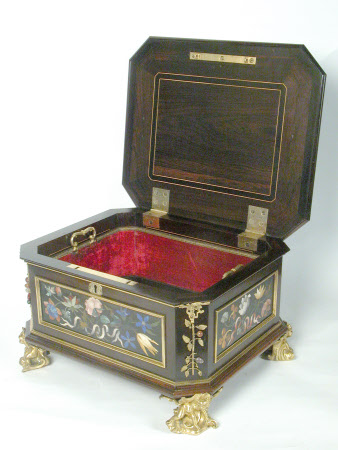Casket
Category
Furniture
Date
circa 1720
Materials
Ebony,walnut, gilt bronze, velvet lining, mosaic plaques " a commesso" of Hardstones and semi-precious stones including Lapis Lazuli, jasper, agate, chalcedony
Measurements
320 x 380 x 480 mm
Place of origin
Florence
Order this imageCollection
Charlecote Park, Warwickshire
NT 534191
Summary
A pietre dura casket, Italy, circa 1720, walnut and ebony, mounted with gilt bronzes and Florentine mosaic plaques with various hardstones and semi-precious stones. The hinged out-swept shaped top is centred by a magnificent plaque of pietre dure depicting a bird seeking insects among flowers. The rectangular plaque is surrounded by four gilt bronze serpentine cartouches, each centred by a stone and incorporating a human head, (possibly an allegory of the seasons). The corners of the top are mounted with a pear-shaped, foliate cartouche. Below are four rectangular plaques of flowers and ribbons, the corners are mounted with carved stones in the shape of fruits attached to a gilt-bronze branch. Sitting on four shell-shaped feet, each with a hiding cherub. Small gilt bronze lock plate to the front. Inside the casket is a wooden removable lining with two silver gilt delicate handles, lined in crimson velvet. This casket was acquired by George Hammond Lucy (1789-1845) at the legendary William Beckford's Fonthill Abbey sale, held by Harry Phillips in 1823. It was described as 'Lot 1151 A magnificent ebony coffer, the panels of beautiful Florentine mosaic; on the corners are bunches of fruit of raised mosaic, with ormolu feet and ornaments, exquisitely chased and gilt, fitted up with internal tray, lined with crimson velvet, with chased handles, locks and hinges silver gilt. Originally from the Pitti Palace, Florence. £105. It now stands on the centre of a table in the drawing room'. (see Mary Elizabeth Lucy, The Lucys of Charlecote, 1862, page 128). Caskets of this type were made by the Florentine Grand ducal workshops. Indeed, the refine composition of the central plaque is typical of the naturalistic treatment of pietre dure mosaics introduced by the Galleria dei Lavori of Grand Duke Cosimo III (died 1723). From 1694 the Grand Ducal workshops were directed by Giovanni Battista Foggini (1652-1725). Influenced by the Roman Baroque creations, in his work Foggini combined ebony, gilt bronze mounts and pietre-dure. Many caskets comparable to the present one are thought to have been designed by him. As precious portable items these caskets were ideal as diplomatic gifts. This casket can be paralleled with a jewelry box with raised mosaics and attributed to Foggini, at The Vyne, Hampshire (NT 1718777.1) purchased by John Chute (1701-1776), probably during his Grand Tour in the 1740s. A close example to The Vyne's casket is in the Minneapolis Institute of Arts (inv.86.85). Reputedly from the Palazzo Pitti, Rome.
Provenance
Presented to the National Trust by Sir Montgomerie Fairfax-Lucy (1896 – 1965), two years after the death of his father, Sir Henry Ramsay-Fairfax, 3rd Bt (1870 – 1944), with Charlecote Park and its chief contents, in 1946
References
Ostergard 2001 : D.E Ostergard, B.McLeod, A. Turpin (and other contributors) : William Beckford, 1760-1844 : An Eye for the Magnificent, Exhibition October 2001-April 2002, The Bard Graduate Center, New York and The Dulwich Picture Gallery, London, 2001 Wainwright, 1989: Clive Wainwright, The romantic interior: the British collector at home, 1750-1850. Studies in British Art. New Haven; London: Paul Mellon Centre for Studies in British Art by Yale University Press, 1989. [Charlecote pp.208-240]

